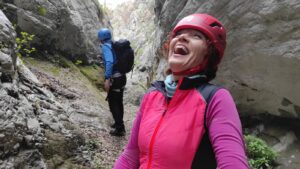Benefits of Climbing
Rock climbing is an indoor and outdoor recreational sport that is one of the world’s fastest growing mainstream sporting activities. It pushes you and makes you want to achieve more, and that’s a skill that’s useful not only on the climbing wall, but in every aspect of your life!!
Once thought of as a sport only for adrenaline junkies, with good instruction and modern safety equipment including our trublue auto belay devices, it is safe and enjoyable for anyone of ages 4 and up to climb at their own comfort and ability level.
The benefits of rock climbing can be summed up into 3 main areas; Physical, Mental and Social.
We’ve included an additional section focusing on Disabled people and the specific advantages they can gain by climbing.
ock Climbing is one of the best total body workouts available. It’s a unique sport in that boys and girls are equally capable. A common misconception is that climbing requires an already strong upper body. This idea often discourages girls from participating. An effective rock climber is one who understands that much of climbing is related to technique, balance and leg strength.
 No matter how strong your upper body currently is, there is a grade you can start at and work from. The motion of climbing works every part of you. From your fingers and forearms as you grip the climbing hold, your abs and core as you lift your legs into position then your whole body as you propel yourself up with your legs and pull up with on your arms.
No matter how strong your upper body currently is, there is a grade you can start at and work from. The motion of climbing works every part of you. From your fingers and forearms as you grip the climbing hold, your abs and core as you lift your legs into position then your whole body as you propel yourself up with your legs and pull up with on your arms.
Climbing develops lean, endurance muscles. It strengthens core muscles better than exercise routines designed to focus on that particular region. The core stabilizes the body, and leads to a stronger, less injury prone body. Climbing strengthens your hands and forearms, biceps, shoulders, neck, traps, upper back, lats, lower back, abs, glutes, thighs and calves. Your entire body, including cardiovascular systems, benefits from rock climbing.
Humans learn to climb before we even walk, pulling ourselves up to get a higher view (or to reach something that looks interesting on the table). Our natural human instinct is to climb anything we can hold onto. That is, until it’s scolded out of us. Kids don’t think about boring things like learning & exercising. They want to have FUN and release energy. In a controlled environment they’ll learn how to productively channel their youthful energy.
This instinct ought to be heartily encouraged, instead of discouraged. The outlet of climbing our walls will benefit the kids in so many ways.
There are many more instances of low muscle tone in kids nowadays than there used to be. This is because our lifestyle simply isn’t what it used to be. Whether you blame technology or fear of injury, the fact remains that our kids are not as active as they should be.
Each climbing route is like a puzzle, which takes patience and planning, forcing the climber to make decisions as one gets to a spot and strategizes where to go from there. Climbing requires for you to make spot decisions as you go, commit and follow through. Your ability to assess a problem, look for a solution, and then execute a plan is required.
Beginners typically decide their route hold by hold, not looking ahead to see the larger picture in front of them. Soon one begins to visualize a route before grabbing the first hold. With practice, the climber is able to see the entire route in his mind, building his problem solving and planning abilities.
Goal setting is a natural development in rock climbing. If you are familiar with a climbing wall you would be aware that it contains several hand and foot holds creating a route for your climb.
Each route has a difficulty rating usually attributed to the size of the holds and the complexity of the path. Once you’ve accomplished a route that’s your highest grade level, the bar is automatically raised. You’ll set your sights on the next grade up, or that epic route you previously thought to be impossible. Sometimes you’ll need to work that route for some time before finally sticking it. The practice of keeping track of those projects and fitness goals helps goal setting become a habit.

